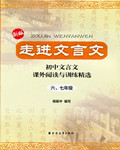题目内容
Book three is ______ most difficult book,but is isn’t ______ most difficult one in Senior school books.
- A.a;a
- B.a;the
- C.the;the
- D.the;a
B

练习册系列答案
 字词句篇与同步作文达标系列答案
字词句篇与同步作文达标系列答案 走进文言文系列答案
走进文言文系列答案
相关题目
题目内容

 字词句篇与同步作文达标系列答案
字词句篇与同步作文达标系列答案 走进文言文系列答案
走进文言文系列答案